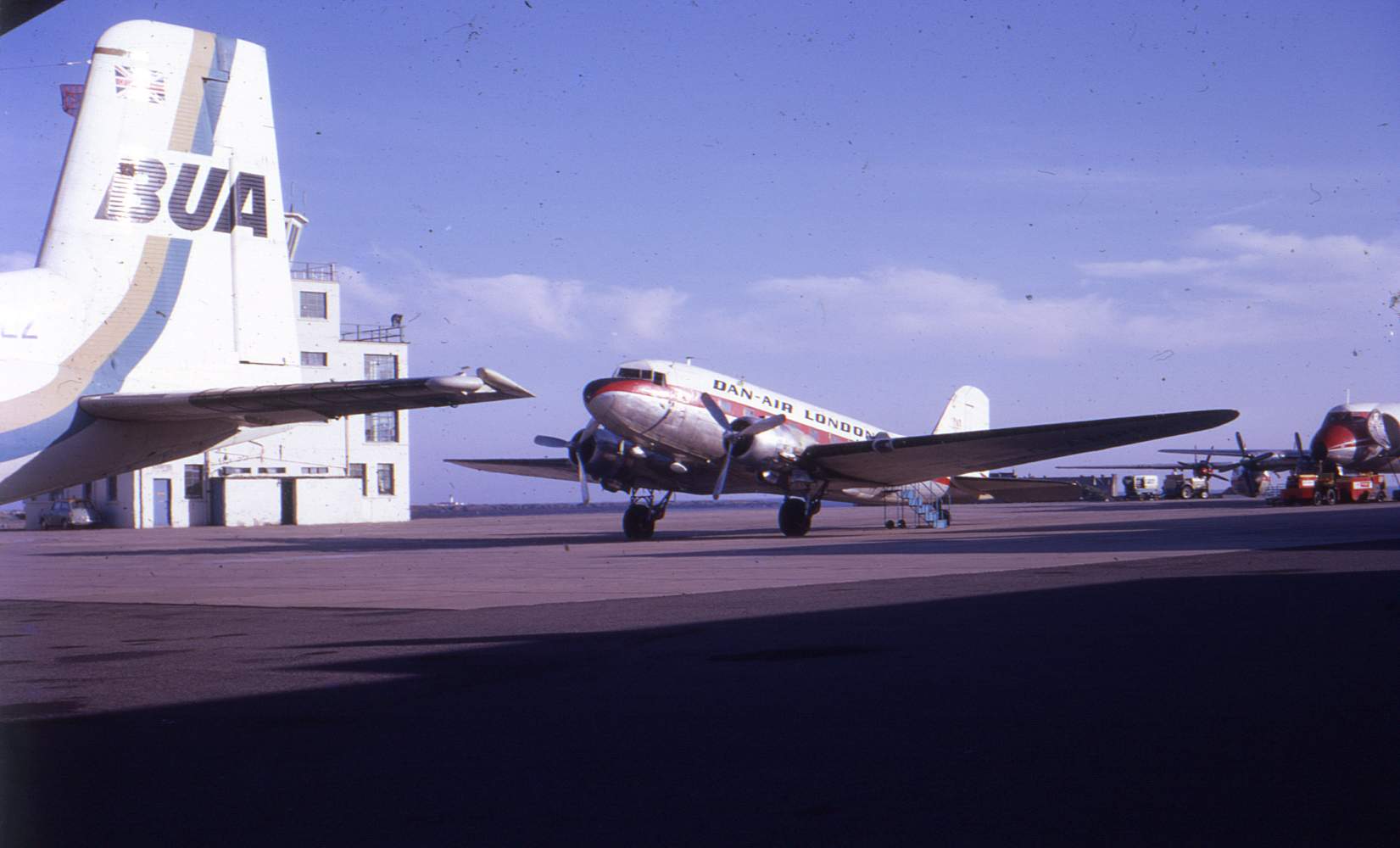The last day of April 1945 proved momentous owing to the suicide of Adolf Hitler in berlin. Two days later, German forces in Italy surrendered and, on May 4th, General Montgomery accepted the unconditional surrender of German forces in the Netherlands, Denmark and NW Germany at Luneburg (1).
(1) Montgomery had chosen Luneburg as his base following its capture on April 18th 1945.
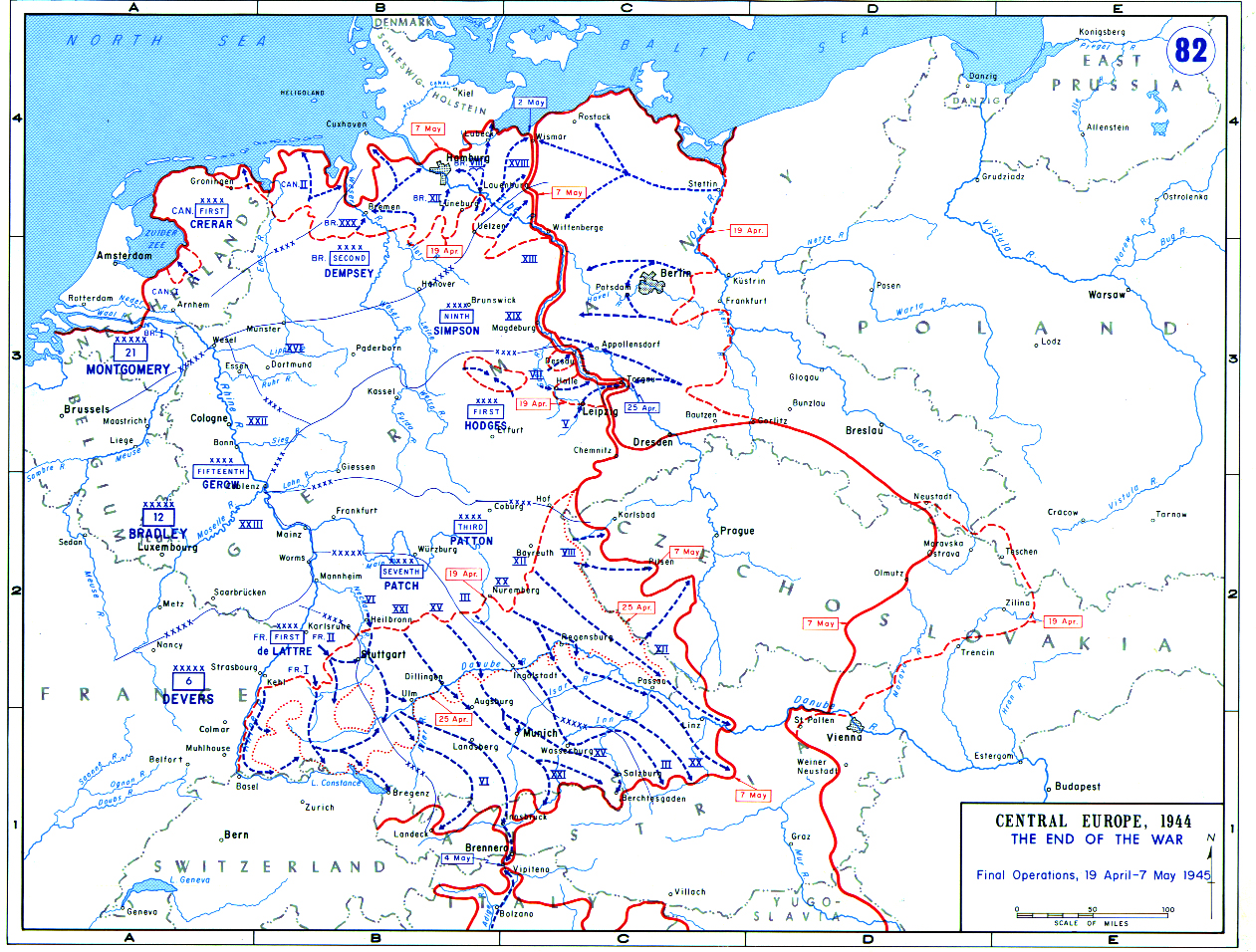
Grand Admiral Karl Doenitz had taken command of the Reich and his hastily-assembled Nazi government had relocated to the old Naval College in the Baltic Sea port of Flensburg, on the border with Denmark. Doenitz delegated Colonel General Jodl to meet with General Eisenhower to sign a surrender document which Doenitz hoped might contain favourable conditions. However, Eisenhower would only accept an unconditional surrender and this was duly signed at the AEF HQ at Rheims on May 7th, specifying a ceasefire at 23:01 the following day. The Russians refused to accept the circumstances of the surrender and stipulated that a formal surrender must be made in Berlin to representatives of all Allied powers. At this stage, 233 Squadron enters the narrative…
On the morning of 7th May 1945, two 233 Squadron Dakotas, KG313 and KG415, were despatched to B118/ Celle carrying full payloads of RAF freight. After arriving and unloading, both aircraft were sent north to B156/ Luneburg on a top-priority mission. By mid-afternoon, they were airborne again and heading to the airfield at Flensburg on the Danish border, briefed that they would be ferrying top-level Nazi Generals to Armistice formalities in Berlin.
KG313, piloted by Flying Officer Diamond, departed from Flensburg the same evening heading for Pilsen, Czechoslovakia, with a German army envoy to the beleaguered German garrison in Prague. Meanwhile, Flying Officer Smith and his crew in KG415 were to make their mark in history the following morning, May 8th.
The mission of KG415 was to carry the German Chiefs-of-Staff to Berlin where they were to sign a formal surrender document approved by all four Allied powers. The passengers were Field Marshal Wilhelm von Keitel (Wehrmacht Chief of Staff), General Admiral Hans von Friedeborg (Kriegsmarine Commander-in-Chief) and Colonel General Hans Jurgen Stumpff (Luftwaffe Chief of Staff) plus fiver further officers and two escorts. The 233 Squadron Dakota was to fly in formation from Flensburg with other aircraft carrying allied dignitaries; departure was delayed until 10:45 to permit some recovery from armistice celebrations of the night before. The allied fleet made an intermediate stop at the advanced airfield R34/ Stendal and a fighter escort was provided for the final 35 minute hop to Berlin’s Templehof Airport. Arriving at 13:00, the Dakota crew were surprised to note that Templehof’s runways and perimeters were serviceable although almost all surrounding buildings had been destroyed. The German officers were disembarked and driven to Karlshorst, passing Schulenburgring where the battle for Berlin had ended on May 2nd to Soviet General Chuikov.
The crew of KG415 clearly spent a pleasant evening with lavish and friendly hospitality provided by the Russian forces. Cue Vodka! The High Command Generals had a more challenging time, meeting allied representatives (2) at 22:00 and eventually signing the surrender document at 00:16 on 9th May CET, some time after the actual ceasefire had been implemented. KG415 departed Templehof at 07:15 on May 9th with the three German generals on board, destination Flensburg. the aircraft returned to B156/ Luneburg late morning on 9th before repositioning to B108/ Rheine to collect 32 ex-POWs for transport to RAF Wing. The Dakota was back on the ground at Blakehill Farm at 21:15.
(2) The signatories on the allied side were Marshal of the RAF, Arthur Tedder, USAAF General Carl Spaatz, French General Jean de Lattre de Tassigny and, for the USSR, Marshal Zhukov.
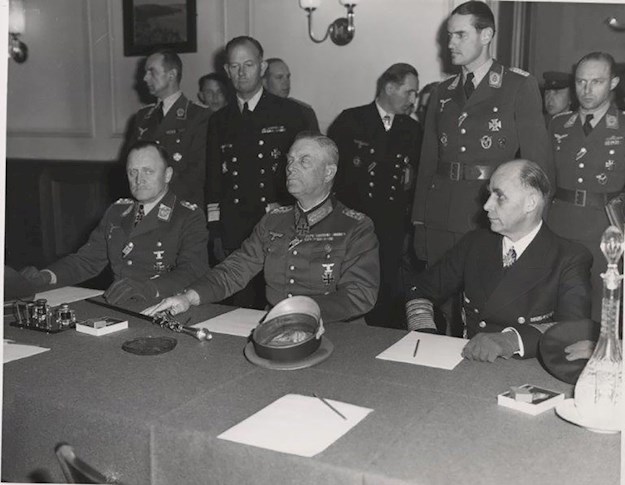
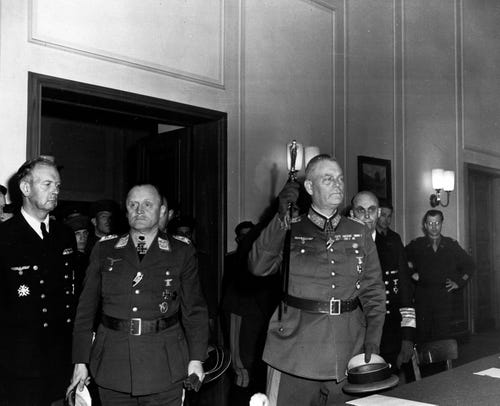
KG313, meanwhile, had also been involved in ceasefire politics. They departed Flensburg at 18:15 on 7th May en route to Pilsen carrying Colonel Wilhelm Meyer-Detring, a German High Command envoy. Meyer-Detring had been tasked with meeting Field Marshal Schorner, German Commander in Prague, to arrange surrender formalities. During early May, Czech partisans, anticipating the arrival of US and Russian forces, had commenced an anti-German uprising in Prague. Schorner was battling this resistance while planning a mass break-out to the west where he planned to surrender to US Forces. KG 313 landed at Pilsen at 2-:35 and Meyer-Detring was immediately driven to Prague to meet Schorner and inform him of the surrender signed by Jodl and Eisenhower at Rheims earlier that day. Although thousands of German soldiers did manage to surrender to American troops, there was no military break-out and the majority of the Wehrmacht forces were captured by the Soviet army when it entered Prague on May 9th/ 10th. Colonel Meyer-Detring had departed Pilsen in KG313 at 08:00 on May 8th, returning to Flensburg via B156/ Luneburg. The Colonel remained in Flensburg while KG313 flew on to Copenhagen carrying SHAEF personnel embarked in Luneburg and Flensburg.
A further surrender drama involved the unintended participation by a 233 Squadron aircrew; indeed it is possible that German forces in Denmark actually surrendered to Pilot Officer Barry Stableford and the crew of FZ678!
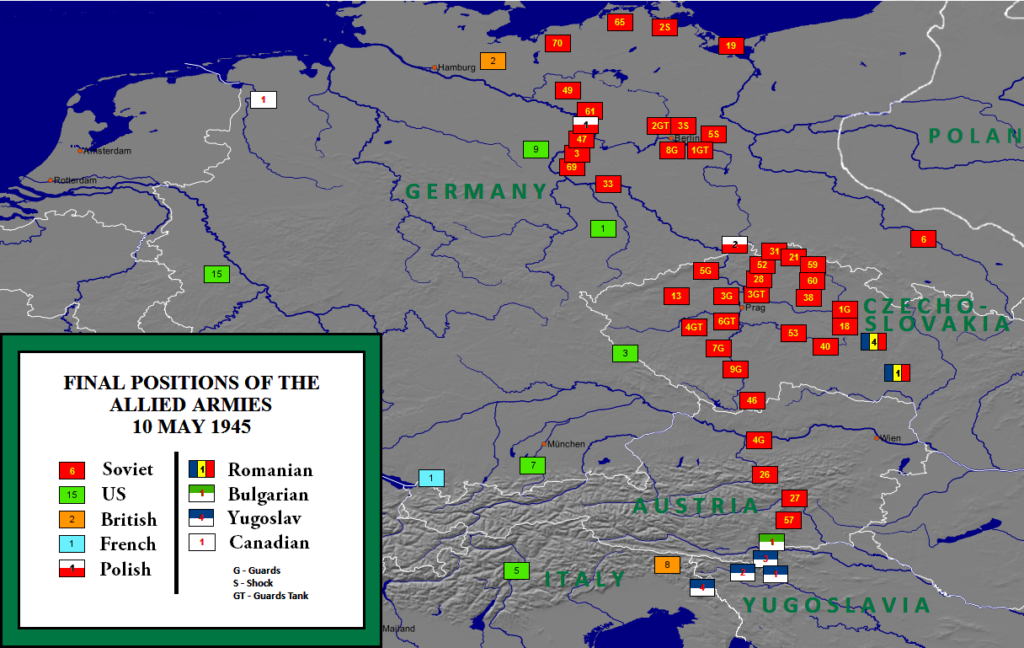
Pilot Officer Barry Stableford, Pilot Officer Terry Holmes, Warrant Officer D.Hastings had crewed FZ681 at Arnhem where the Captain, Warrant Officer Ken Cranefield, had won a DFC. They had returned to 233 Squadron operations in April 1945 with promotions but no medals. They were joined by Flt.Sgt Broom as second pilot and, on May 3rd, departed Blakehill Farm in FZ678 en route to B75/ Nivelles with a load of petrol. From Nivelles, they were routed north to B156/ Luneburg with freight and then returned to B56/ Evere where technical attention was required for FZ678. Serviceability issued cured, they were still in Brussels on the morning of May 5th and were assigned a new mission: delivering kitchen utensils and food to a soon-to-be-liberated Copenhagen. General Montgomery had accepted the surrender of German forces in NW Europe at Luneburg on May 4th and a high priority was for the RAF to deliver the British General Richard Dewing to Copenhagen in his capacity as Head of SHAEF mission to Denmark. 512 Squadron had been allocated the task of delivering the General and his team to Copenhagen but there were also many other operations scheduled from the very hectic airfield at Evere. Having been sitting, fully loaded and awaiting departure instructions for some time, the crew of FZ678 were becoming eager to depart and prompted Evere Operations for a take-off slot. Air Traffic Control were awaiting news that 512 Squadron were already en route to Copenhagen before releasing the Dakota but eventually gave the go-ahead and FZ678 was airborne at 10:50, routing to B60/ Grimbergen, B156/ Luneburg and,eventually, across the border to Copenhagen. Pilot Officer Terry Holmes’ navigation delivered them to Kastrup without issue and Wireless Operator Hastings attempted to raise the airport’s Approach Control on the W/T. There were definite signs of activity over Copenhagen with a squadron of Dakotas in formation with a fighter escort, but FZ678 couldn’t raise either them or the airport on the radio. The airfield looked clear and unobstructed so, without further preamble, Barry Stableford completed final approach and touched down at 16:32. Taxiing to the main block of terminal buildings, they were marshalled onto an apron by what looked worryingly like fully-armed German soldiers. Too late for a change of mind, the crew shut down the engines, grabbed their documents briefcase and mackintoshes (after all, it looked like it might rain) and de-planed. By now, the Dakota was being approached by two greatcoat-clad Germans with a bunch of flag waving civilians sporting Union Jacks, Danish flags and Stars and Stripes corralled in the background. The Germans proved to be the Airport Kommandant and his deputy and, following a ‘stiff salute’, they promptly surrendered the airfield to the rather diffident-looking Dakota crew. Spotting a certain retinence, the German Colonel double-checked his knowledge of British uniforms by asking: “You are a General, Nein?”. Pilot Officer Stableford admitted that Nein, he wasn’t. At this point the Colonel exhibited either a severe loss of interest in the war or quirky teutonic humour, by laughing and saying “But I still surrender to you!”. Job done, the two officers turned on their heel and departed. As several other Dakotas were now touching-down, the crew decided it was high time to melt into the admiring crowd of celebrating Danes and comely ladies. The rest of their stay was, of necessity, spent avoiding General Dewing and his entourage. While the fighting in Copenhagen was officially over, there was still some shooting going on in the city as Danish patriots and the German-supporting HIPO settled scores. Nonetheless, the crew enjoyed a safe stay in the Danish capital, departing on the morning of May 7th bound for B156/ Luneborg with an ex-Prisoner of War and a war reporter. They loaded 24 casualties in Luneborg for the two hour flight to B56/ Evere. The final leg of their tumultuous journey carried 26 passengers back to Croydon prior to the forty-minute hop to Blakehill Farm.
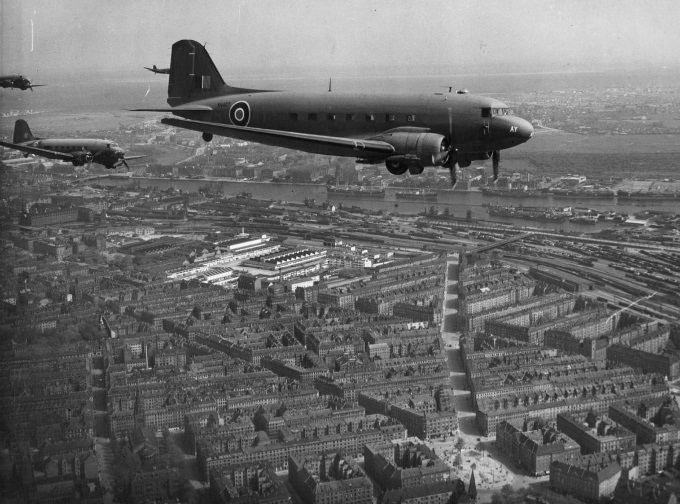
KG437 and Flt.Lt Bentley’s crew were assigned to flying duties from B166/ Flensburg on 12th May. Their work commenced with the pick-up of three senior SHAEF personnel at Rheims. Their route to Flensburg was via the Ruhr for observation of the damage wrought by the advancing allies. For the next 15 days the crew would be billeted on the accommodation vessel SS Patricia moored offshore Flensburg. Although missing out on many of the ‘big name’ flights associated with the armistice, their operations did include flights to Versailles, Brussels, Frankfurt, Salzburg and Paris.
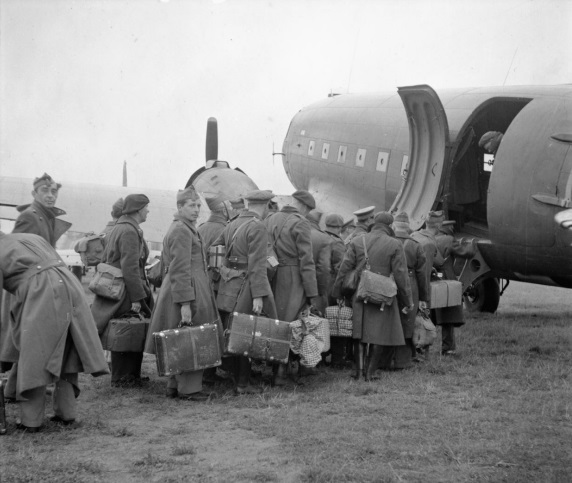
Regular Operations
Aside from the glamour of special missions, intended or accidental, the Squadron’s transport duties rolled along fairly predictably in May 1945. Outward loads were often petrol, service freight or troops while repatriated POWs were a priority on the return leg. Often up to 20 aircraft might be assembled for a petrol-delivery flight to B56/ Evere or B75/ Nivelles. Ex-Prisoners of War continued to be returned primarily to RAF Wing, Dunsfold and Oakley from B56/ Brussels Evere. Further afield, ex-POWs were often collected at B114/ Diepholz and flown to B56. On many days, double trips were operated: for example, on May 10th, FZ681 flown by Flt.Lt.Priestley’s crew travelled from Blakehill Farm to B56, transferred freight to B114/ Diepholz and returned to B56 with 33 ex-POWs. A second circuit the next morning took freight from Brussels to B154/ Reinsehlen arriving at 10:45 followed by an empty leg to Diepholz to collect 29 POWs bound for Brussels. Leaving Brussels at 15:15, FZ681 was flown to B156/ Luneburg with 5000 lbs of freight before hopping back to B114/ Diepholz. Apparently, there were no further takers for flights to either Brussels or the UK and FZ681 returned empty to Blakehill Farm arriving at 21:20.
On some days, aircraft were sent empty to Brussels specifically to collect ex-POWs. On May 13th nine aircraft flew 30 ex-POWs each between Brussels and RAF Wing followed by a second round trip to Brussels and Wing the same afternoon. Seven aircraft carried-out a similar double trip to collect ex-POWs from B56 the following day with their passengers delivered to Tangmere, Oakley and Dunsfold.
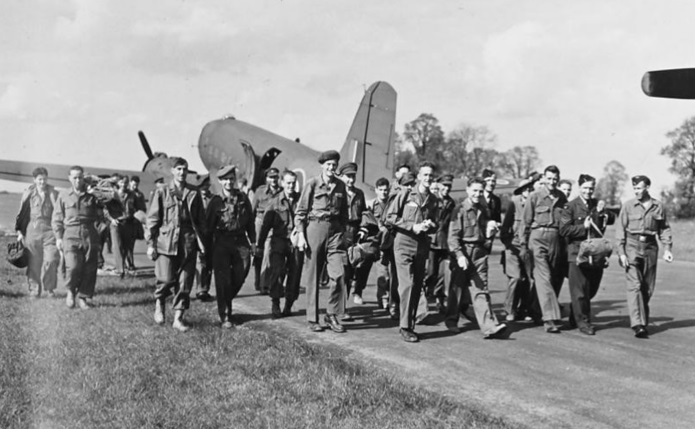
Freight and munitions flights moved further east into occupied Germany during May. Regular airfields visited included B118/ Celle, R17/ Gottingen, R31/ Merseburg, B114/ Diepholz, R16/ Hildesheim, Lubeck, B154/ Reinsehlen, B152/ Fassberg and B116/ Wunsdorf. Some of these would become established RAF airfields which would be pivotal during the Berlin Airlift operations later in the decade.
The Stableford crew were entrusted to visit Copenhagen again on May 15th. They departed from Blakehill Farm in KG585 on 14th May for the half hour flight to Matching in Essex.Twenty four troops were embarked for the North Sea crossing to B56/ Brussels. Evere provided 30 ex-POWs for the return flight to Oakley. A second circuit was then flown with KG585 travelling empty to B56 to collect another 32 Oakley-bound ex-POWs. The last flight of the day was an empty sector to B56/ Evere. The next morning, KG585 headed west to Dunsfold with another 32 ex-POWs. A 30 minute hop brought them back to Blakehill in time for lunch. KG585 was fuelled and loaded with 5000 lbs of freight and P.O Stableford took off again at 14:20 en route to Copenhagen for a second visit. The Danish capital was now a frequent destination for 233 Squadron with freight flights operated there from Blakehill, Evere and Boreham almost every day in mid-May. B156/ Luneburg also proved popular. With so many diverse operations, there was occasionally a degree of confusion and, foe example, on May 15th/ 16th Flying Officer Smith’s crew shuttled FZ681 on a 7-sector mission incorporating Flensburg, Copenhagen, Celle and Luneburg with payload carried on only two sectors.
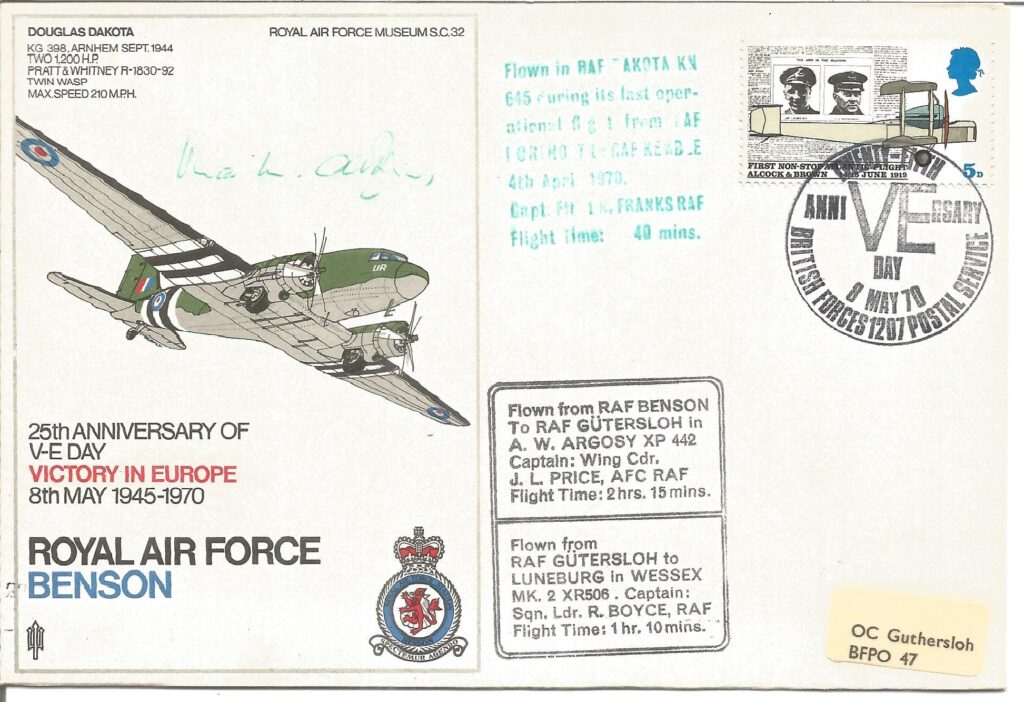
Norway had also been liberated from German occupation during the second week of May and British General Andrew Thorne took over as de facto Head of Government until the arrival of King Haakon on June 7th. A couple of 233 Squadron Dakotas were early visitors to Oslo with FZ688 arriving at the Norwegian capital from Boreham on May 15th via Sumburgh in Shetland carrying 4940 lbs of freight and a jeep. KG313 and KG341 repeated the route to Oslo the following day carrying equipment, passengers and mail. The return flights were staged via continental airfields at Copenhagen, Luneburg and Celle. On May 22nd, two further flights were made to the Oslo airports of Gardermoen and Fornebu via Leuchars in Fife with return flights routing through Sumburgh (3).
During the third week of May, the Squadron flew a number of operations returning Airborne forces from B156/ Luneburg to their base at Netheravon. Several passenger flights were also made from Gatwick and Croydon to continental destinations. 233 Squadron aircraft carried RCAF and USAAF personnel, displaced persons, French and Belgian ex-POWs, captured German soldiers and senior allied military personnel during May 1945. In the last week, several flights were made between the Hampshire airfield of Ibsley and Guernsey – amazingly, the Channel Islands had only been liberated on May 9th 1945.
(3) 233 Squadron’s Blakehill Farm co-tenants, 437 Squadron RCAF, flew an early flight into Oslo on May 10th and one of their aircraft carried the German Peace Delegation to Scotland.
Hits: 397
